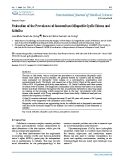
Idiopathic edema
-
Tuyển tập các báo cáo nghiên cứu khoa học ngành y học tạp chí Medical Sciences dành cho các bạn sinh viên ngành y tham khảo đề tài: Evaluation of the Prevalence of Concomitant Idiopathic Cyclic Edema and Cellulite...
 3p
3p  thulanh9
thulanh9
 07-10-2011
07-10-2011
 34
34
 2
2
 Download
Download
-
Erythroderma (Table 54-2) Erythroderma is the term used when the majority of the skin surface is erythematous (red in color). There may be associated scale, erosions, or pustules as well as shedding of the hair and nails. Potential systemic manifestations include fever, chills, hypothermia, reactive lymphadenopathy, peripheral edema, hypoalbuminemia, and high-output cardiac failure. The major etiologies of erythroderma are (1) cutaneous diseases such as psoriasis and dermatitis (Table 54-3); (2) drugs; (3) systemic diseases, most commonly CTCL; and (4) idiopathic.
 9p
9p  konheokonmummim
konheokonmummim
 30-11-2010
30-11-2010
 81
81
 7
7
 Download
Download
-
Edema of Heart Failure (See also Chap. 227) The presence of heart disease, as manifested by cardiac enlargement and a gallop rhythm, together with evidence of cardiac failure, such as dyspnea, basilar rales, venous distention, and hepatomegaly, usually indicate that edema results from heart failure. Noninvasive tests, such as echocardiography, may be helpful in establishing the diagnosis of heart disease. The edema of heart failure typically occurs in the dependent portions of the body.
 5p
5p  ongxaemnumber1
ongxaemnumber1
 29-11-2010
29-11-2010
 65
65
 2
2
 Download
Download
-
Additional Factors in Diagnosis The color, thickness, and sensitivity of the skin are significant. Local tenderness and warmth suggest inflammation. Local cyanosis may signify venous obstruction. In individuals who have had repeated episodes of prolonged edema, the skin over the involved areas may be thickened, indurated, and often red. Estimation of the venous pressure is of importance in evaluating edema. Ordinarily, a significant generalized increase in venous pressure can be recognized by the level at which cervical veins collapse (Chap. 220).
 5p
5p  ongxaemnumber1
ongxaemnumber1
 29-11-2010
29-11-2010
 71
71
 2
2
 Download
Download
-
This syndrome, which occurs almost exclusively in women, is characterized by periodic episodes of edema (unrelated to the menstrual cycle), frequently accompanied by abdominal distention. Diurnal alterations in weight occur with orthostatic retention of NaCl and H2O, so that the patient may weigh several pounds more after having been in the upright posture for several hours. Such large diurnal weight changes suggest an increase in capillary permeability that appears to fluctuate in severity and to be aggravated by hot weather.
 6p
6p  ongxaemnumber1
ongxaemnumber1
 29-11-2010
29-11-2010
 46
46
 2
2
 Download
Download
CHỦ ĐỀ BẠN MUỐN TÌM

















